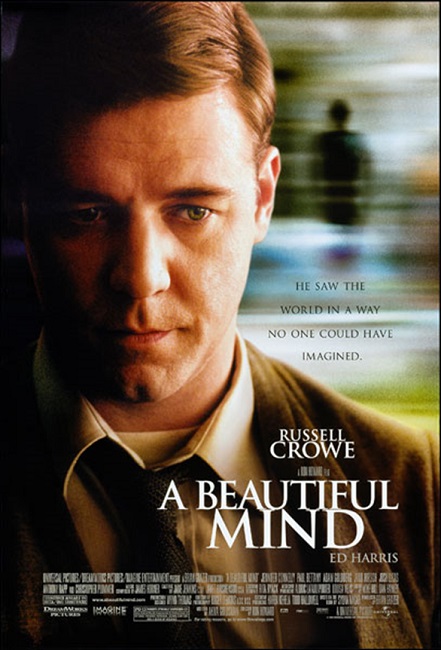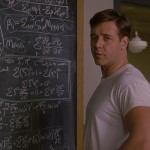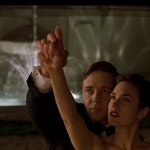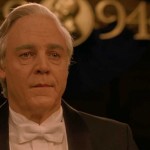
A Beautiful Mind – 2001
Here we have another movie starring Russell Crowe, which makes two years in a row, in which he was in the Best Picture winning film. It just emphasizes the fact that Crowe is a very good actor. And he is versatile as well. The character of Maximus Decimus Meridius is like a polar opposite from the man he plays in this film.
He plays the genius level mathematician, John Forbes Nash Jr. The film is, admittedly, only loosely based on the real Nobel Prize Winner. The filmmakers over-dramatized the real events and characters, changed several key points, and left out a few important details. I’ll explain. But in order to do so, I first have to delve into the plot and characters a bit.
John Nash is a prodigy in mathematics. He goes to Princeton University and right from the beginning, he is bored with his classes. He thinks that all the concepts being taught are unoriginal. It becomes his goal to excel and succeed by coming up with a completely original idea that will blow everybody’s socks off. His fellow students laugh at him and his teachers are disappointed in his performance. He spends all his time in independent study and does not attend his classes.
He is socially inept when dealing with his peers, and is positively shocking when it comes to interacting with the opposite sex. But he perseveres in his personal crusade, despite the bad influence of his roommate, Charles Herman, played by Paul Bettany. Charlie gets him to leave his studies when he forgets to do things like take a break, relax or even eat. And eventually, the brilliance of his incredible intellect comes into focus.
Just when everybody is ready to give up on him as a lost cause, he finds his original idea and writes a paper for Professor Helinger, played by Judd Hirsch. His paper is so revolutionary and extraordinary, a concept that flies in the face of a hundred years of theories and practices in the field of economics, that he is validated. Above all of his classmates, he is offered his pick of any job he wants. He even gets to name two fellow students to go with him as his personal team. He chooses two men, Sol and Bender, played by Adam Goldberg and Anthony Rapp, respectively, and they get jobs at MIT.
Eventually, he takes a consulting job at the Pentagon where he meets William Parcher, played by Ed Harris. Parcher gives him an assignment cracking codes, saying that the Russians are planning to detonate a bomb somewhere in the U.S.. Nash now thinks of himself as a reluctant spy. Meanwhile, Charlie comes back into his life. This time he has his niece, Marcee, with him, played by young actress Vivien Cardone.
And lest we forget, along the way, he meets and marries an MIT student named Alicia, wonderfully played by Jennifer Connelly. The big romance of the movie begins, and after difficult courtship, she agrees to marry him. But then we discover that the characters of Charlie, Marcee and Parcher, people he has known for years, don’t exist – at least not anywhere outside of Nash’s mind. It turns out that he is a paranoid schizophrenic.
Interesting note: Something that never caught my attention in the film, but I discovered as an interesting little trick Ron Howard slipped into the film. At one point the character of Marcee runs through a field of birds. None of the birds move, proving that she doesn’t exist. Clever and subtle, Mr. Howard.
OK, now, this is how the movie differs from reality. First of all, the real John Nash only had auditory hallucinations, not visual. To me, that seems like a pretty big one. Second, Nash never had a job at the Pentagon. Third, the movie skips over the fact that Nash fathered a child, John David Stier, out of wedlock with a woman named Eleanor Stier. But after learning she was pregnant, he refused to marry her, thinking her below his status. He abandoned her and the child.
The movie never mentions the fact that John’s wife Alicia divorced him in 1963 and remarried him in 2001. The movie also fails to show his arrest for indecent exposure in Santa Monica, California in 1954. In addition, the portrayal of the Nobel Prize ceremony is quite fictional. The Prize ceremony is one without speeches. Also, he was not the only man to win the prize that year. He shared the honor with John Harsanyi and Richard Selten.
Interesting note: There was another historical inaccuracy in the film on which John Nash, himself, commented. In the film, the old (around the time of his Nobel Prize accolade) Nash mentioned that he was still taking newer medications to help control his mental illness. In fact, this was not true. The real Nash said that he no longer took any medication. Howard defended the film saying that he did not want to encourage the notion that all schizophrenics can overcome their illnesses without medication.
But never-mind all that. There were specific reasons why Director, Ron Howard, made the changes he did, and ignored several of the more unsavory facts of the man’s life. Knowing that A Beautiful Mind was never intended to be a literal translation of the life of John Nash, I find the changes easy to accept. I am not a purest, and neither has Hollywood ever been, though filmmakers are always persecuted when they make such changes. It is a dramatized story of the man’s professional life and it was meant to adhere to a dramatic and sometimes romantic narrative, not literal reality.
So, putting all those historical facts aside, the story that Ron Howard told was incredibly well put together. It was very dramatic, and yet realistic and emotionally engaging. The romance between John and his wife Alicia was really played-up, making the socially inept character of Nash almost charming at times. This was a very specific request that Howard made of screenwriter, Akiva Goldsman.
Russell Crowe and Jennifer Connelly were phenomenal in their portrayals. I already knew that Crowe was an exceptional actor, and though I have only seen a few of the movies in which he has starred, I would venture to say that this was one of the finest performances of his career. He really had an opportunity to get into a unique role and show his acting chops. For me, he knocked this one out of the park. I was both shocked and dismayed to learn that he did not win the Academy Award for Best Actor, though he was at least nominated.
And Connelly really surprised me along with most of Hollywood. She was gorgeous and elegant. She showed real emotional depth that the world had not yet seen from her. Her performance earned her the Academy Award for Best Supporting Actress. She really was incredible, and a pleasure to watch.
Other actors whom I liked were Josh Lucas as Martin Hansen, a fellow classmate, the leader of those who taunted Nash at Princeton, and Christopher Plummer as Dr. Rosen, the psychologist who treats Nash when he is admitted to the mental institution. Lucas, I must admit, has always had a face that naturally says, “jerk” to me. But his character turned out to be gracious and sympathetic to Nash and I ended up liking him. Well done, Lucas. And Plummer also did a fine job. His character was that of a doctor who truly cared about his patient, and did his best to help and comfort him.
When it comes to Ed Harris, I was rather unimpressed, but this was not the actor’s fault. The character just didn’t stand out for me. Harris did a good enough job as the mysterious government agent, but the role was just too one-note and uninteresting to allow Harris to do much with it.
The music for the film was written by James Horner. Horner wrote a score that really tapped into the somewhat sterile precision of mathematics, while at the same time, enhancing the emotional content of the film. He has written other such great movie scores as Star Trek II: The Wrath of Khan, Field of Dreams, Legends of the Fall, Apollo 13, Braveheart, Titanic and Avatar. He really knows what he is doing and his score for A Beautiful Mind really caught my attention.
Another thing that was noteworthy about the film was the sets and costumes. The movie covered Nash’s life between 1947 and 1994 – a period of 47 years. All the sets and costumes remained quite true to their proper eras. The clothing and cars from the 1940s all appeared authentic and well thought out. Even the hairstyles of the students at Princeton University looked like something you would expect from that time in history.
And at the end of the movie, before the credits start, a little blurb is shown on the screen. It says, “Nash’s theories have influenced global trade negotiations, national Labor Relations, and even breakthroughs in evolutionary biology. John and Alicia Nash live in Princeton, New Jersey. John keeps regular office hours in the mathematics department. He still walks to campus every day.” I like it when films give a little extra meaningful information like that at the end.
All in all, this was a good film. The acting was phenomenal and the plot was engaging, if not historically accurate. It is a movie that never fails to catch my attention. I have come to expect a certain level of quality from any film directed by Ron Howard. A Beautiful Mind did not disappoint.








